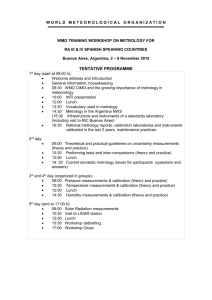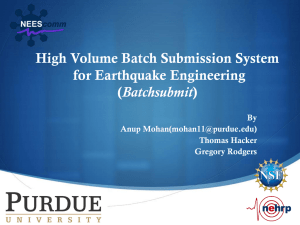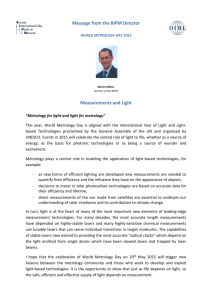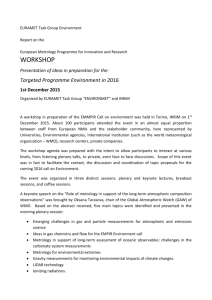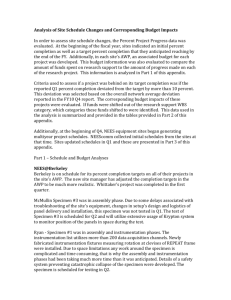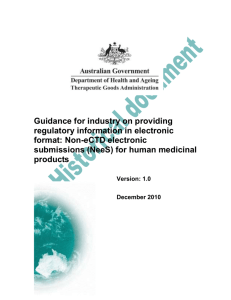the study and practice of metrology at the university of buffalo nees site
advertisement
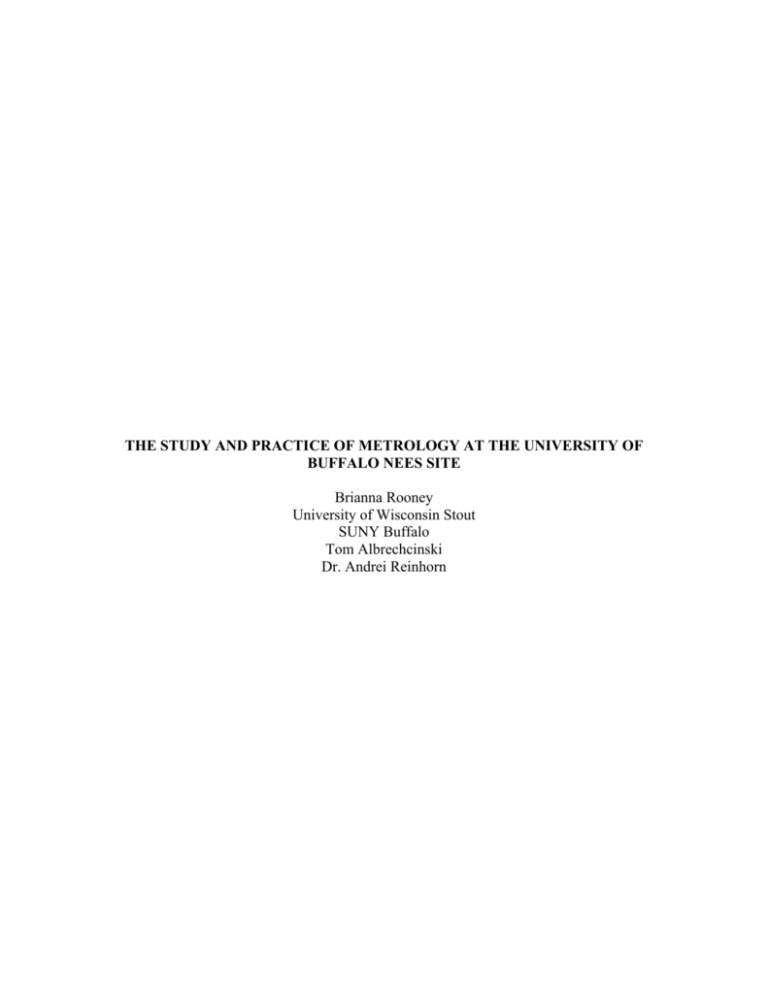
THE STUDY AND PRACTICE OF METROLOGY AT THE UNIVERSITY OF BUFFALO NEES SITE Brianna Rooney University of Wisconsin Stout SUNY Buffalo Tom Albrechcinski Dr. Andrei Reinhorn Abstract: This paper summarizes my research project as a NEESreu at the University at Buffalo. The projected I was assigned was one of importance NEES-wide and throughout the world. My project was the study and implementation of metrology at UB-NEES. My ten-week session at UB NEES included review of literature, a detailed survey and understanding of the UB NEES laboratory manual, hands-on laboratory experience with instrumentation and data acquisition systems, and observation and assessment of UB NEES’s archiving practices. Supplementary to this experience, my involvement allowed UB NEES to update the laboratory manual in areas of need. Metrology When I first came to UB NEES, I felt I was in way over my head. I come from a chemistry and biology background and found myself in a hard-hat and steel toe wearing structural laboratory. I was first assigned to work on a project with the Real Time Dynamic Hybrid simulation. This assignment did not work for what I was trained in and I was unhappy working on it. Then Tom Albrechcinski had the idea for me to work with metrology. Coming from a chemistry and biology laboratory background, I was familiar with the need for calibrating instruments, but I was unfamiliar with the extent of it. Metrology worked well with the background I came to Buffalo with, and I will be able to use what I learned in the ten weeks I was at UB NEES in the future with my continual study in chemistry. Introduction: The study of measurement, or metrology, is an important area to science in not only a Structural Engineering and Earthquake Simulation Laboratory, but in aspects of the every day. Webster’s Dictionary defines metrology as n. the science of weights and measures or of measurement. The study of metrology dates back to the ancient Egyptians. Around 3000 B.C. the Egyptians created the Royal Egyptian Cubit, figure 1, meaning the measurement between the elbow and middle finger plus a palm width of the ruling pharaoh (NCSL, 1996). Metrology has since grown to include chemistry, cooking, construction, engineering, etc. As a chemist metrology was the one area of study in a structural engineering laboratory I could relate to having calibrated instruments in chemistry laboratory. My initial study of metrology started with reviewing the University of Buffalo’s Network of Earthquake Engineering (UB NEES) laboratory manual, review of data acquisition systems, learning and implementing calibration techniques to strain gauges, load cells, string pots, and accelerometers, and ended with observation of UB NEES’s archiving techniques. Figure 1 (Wikipedia, 2007) Laboratory Manual The UB NEES laboratory manual is a comprehensive document, which details the laboratory facilities, equipment, support facilities, organization, past experiments, calibration certificates and procedures, and a list of inventory. My work with the laboratory manual was in the calibration certificates and procedures. When instrumentation came in from being nationally calibrated at MTS Systems Corporation, they came with a certificate of calibration. This certificate needed to be copied and uploaded onto the laboratory manual website. I will talk more about this process in archiving and traceability. The complete manual can be found on the World Wide Web at http://nees.buffalo.edu/docs/labmanual/html/. Data Acquisition Systems The largest data acquisition (DAQ) system at UB NEES is the Pacific DAQ, figure 2. This system is composed of 240 channels for acquisition. This DAQ system is used for the biggest experiments at UB NEES. While I was working at UB NEES, this system was being used for the NEES Collapse experiment. This experiment is outlined in the papers my colleagues, Melissa Norland and Mathew Alboum. Figure 2, Pacific DAQ (Weinreber, 2007) The second largest DAQ at UB NEES is the MEGADAC DAQ, figure 3. This DAQ has about half of the channels of the Pacific with 128 channels. This system is used for smaller experiments that do not require as much instrumentation. The main advantage to using the MEGADAC over the pacific is its ability to acquire date simultaneously from multiple input sources. The ability to acquire simultaneous data is important when a test requires many different types of instrumentation. Figure 3, MEGADAQ (Weinreber, 2007) LabView is the smallest DAQ systems of the three I observed. LabView contains 16 input channels and is primarily for industry testing. The biggest advantage of LabView is its portability, as seen in figure 4. LabView can be placed on a cart and moved to different experimental sites. Figure 4, LabView (Weinreber, 2007) Calibration Techniques One of the most important aspects to metrology is the calibration of instruments. The definition of calibrating is to standardize (as a measuring instrument) by determining the deviation from a standard to ascertain the proper correction factors or to measure precisely especially: to measure against a standard (Webster’s, 2007). At UB NEES, calibration of instruments is performed before every experiment by calibrating it to a laboratory standard, which is in turn calibrated once a year to a national standard. The only way to guarantee accurate data is to assure the accuracy of the instruments collecting data. By calibrating experimental instruments to a laboratory standard, the accuracy of the data collected can be assured. The instruments I worked on included strain gauges, load cells, string pots, and accelerometers. Strain gauges, Figure 5, measure the deformation of a specimen (Wikipedia, 2007) during application of force. The most common type of strain gauge used consists of a Wheatstone bridge. A Wheatstone bridge, as pictured in Figure 6, measures an unknown electrical resistance, caused by deformation, by balancing two legs of a bridge circuit, leaving one side unknown. When the unknown resistor is deformed, the voltage is changed. This change of voltage can be recorded using a data acquisition system and then can be compared to the readings of the known bridge leg. The unknown voltage can then be determined by equation 1. Rx = R1 * R3 (Eq 1) R2 Figure 5, strain gauge (Weinreber, 2007) Figure 6, Wheatstone bridge circuit (Wikipedia, 2007) Load cells, figure 7, convert a force into voltage. We used a 2310 signal converter, figure 8, to calibrate the load cells for the second NEES collapse project. We calibrated a known force, 14000 psi, to 10000 volts on the 2310 signal converter. We loaded the load cells to 14000 psi using a hydraulic system. I then adjusted the signal converter to 10000 volts, calibrating the load cell for 14000 psi to equal 10000 volts. We unloaded the load cells to zero psi and then reloaded them to 14000 psi and unloaded them again, graphing the results in LabView. By creating a graph, changes in voltage readings can be applied and interpolated on the graph. Figure 7, load cell (Albrechcinski, 2007) Figure 8, 2310 signal converter (Weinreber, 2007) String pots, figure 9, measure the displacement of an object during movement. We calibrated the string pots using MEGADAC, a data acquisition system, and a known distance, figure 10. We placed the string pot on the instrument of known distance, and took a reading of zero inches on the MEGADAC with the string fully retracted. We then hooked the string to the end of our known distance, in this case 23.99 inches, and recorded the distance on MEGADAC. We then installed the string pots on the test specimen with their strings at zero inches. Figure 9, string pot (Weinreber, 2007) Figure 10, string pot calibration length (Weinreber, 2007) Accelerometers measure acceleration due to gravity in an experiment. Statically, they are the easiest instrument to calibrate since the only requirement is the known constant of gravity at the altitude of the experiment. Dynamic testing can also be utilized with accelerometers and is discussed in my colleague, Atia Syed’s, paper (Syed, 2007). To calibrate an accelerometer using the static method, the accelerometer is placed face up, figure 11, which records at one g. The accelerometer is then flipped to the other side, figure 12, which then records negative one g. Another data point can be taken with the accelerometer on its side, figure 13, and recorded at zero g. Figure 11, accelerometer at 1 g (Rooney, 2007) Figure 12, accelerometer at -1 g (Rooney, 2007) Figure 13, accelerometer at 0 g (Rooney, 2007) Archiving and Traceability Another important branch of metrology contains traceability and archiving. Traceability includes the ability to trace a laboratory standard calibration to a national standard. This is important because all lab equipment is calibrated to the laboratory standard before being used on an experiment. If an audit of the data is necessary, the data can be certified because of traceability. The chain of traceability works from the experiment instrument to the laboratory standard, and then to the national standard, as outlined in figure 14. Figure 14, Chain of Traceability (Rooney, 2007) Instruments are sent out once a year to be calibrated to a national standard at MTS Corporation or to manufacturer. When an instrument returns from calibration by MTS Systems Corporation, or the manufacturer, it includes an official calibration certificate. This certificate includes the name of the instrument, calibration data, and the date of the calibration. Jason Hanley, an information technology specialist, then scans and uploads the certificate onto the laboratory manual website. After the certificate is uploaded onto the website, it is taken into the SEESL office and filed by category. By systematically filing the certificates, they are easily accessible to anyone with questions about the accuracy of an instrument. Future Work The field of metrology is an ever-changing area of study. New methods of calibration are discovered daily. As I mentioned before, UB NEES is now implementing a dynamic procedure for the calibration of accelerometers. In addition to new methods being developed for calibration, the laboratory manual needs to be updated with new calibration certificates, changing instrument data, and new equipment. Acknowledgements I would first like to thank NEES for giving me this ten-week opportunity to become familiar with and learn about metrology. I would like to thank Dr. Andrei Reinhorn for his advisement throughout the process and being available for questions. I would also like to give a huge thank you to Tom Albrechcinski, the NEES site coordinator, who acted as my mentor. He was crucial in my experience through placement of my services, outlining my project, always being available for questions and concerns, and acting as a friend through the experience. I would not have been able to work in the lab had it not been for Chris Budden, the senior research support specialist. I worked under his supervision while in the lab and he taught me the ins and outs of instrument calibration. I would like to thank my fellow REU students for their support and help in understanding structural engineering. My last thank you is for the staff of the SEESL lab at UB NEES. It was through their guidance I was able to work and learn at UB NEES for 10 weeks References • Weinreber, S. Metrology PowerPoint, 2007 • http://www.ncsli.org/misc/cubit.cfm • www.websters.com • www.wikipedia.com
